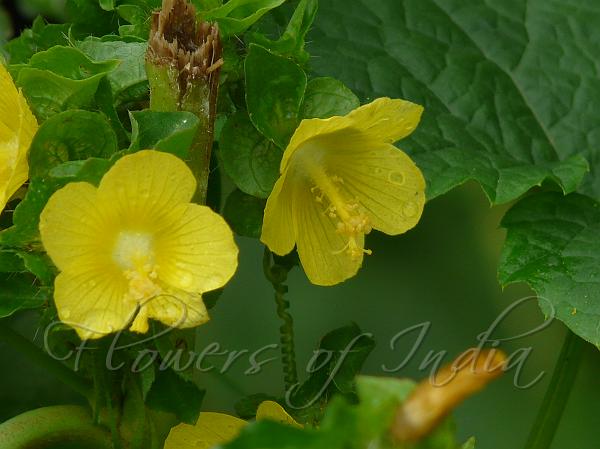|
| Brazil Jute |
|

|

| File size | 1566507 |
| Original date | 9/20/08 12:47 PM |
| Resolution | 2048 x 1536 |
| Flash | Flash did not fire, auto |
| Focal length | 82.8mm |
| Exposure time | 1/250s |
| Aperture | 5.6 |
| Focus Distance | |
| Metering Mode | Multi-segment |
| Camera make | Panasonic |
| Camera model | DMC-FZ18 |
| Sensor type | OneChipColorArea |
|
|
|
| Photo: Dinesh Valke |
Botanical name: Malachra capitata Family: Malvaceae (Mallow family)
Synonyms: Sida capitata
Synonyms: Sida capitata
Brazil Jute is a coarse, erect, simple or branched, annual herb 0.5-2 m
high, which is covered with hairs. The leaves are circular, 5-15 cm in
diameter, obscurely and shallowly lobed, finely toothed, and somewhat
heart-shaped at the base. The flowers are borne in axillary and terminal
heads. Sepals are short, and slenderly pointed at the tip. The
petals are yellow, overlapping, and about 1 cm long. The bast (inner fibrous
bark) is strong and is used in the manufacture of rope. The fiber is
excellent, 8-9 feet long, and that experts have declared it little, if at
all, inferior to jute. Brazil Jute is native to Tropical America, cultivated
and naturalized elsewhere.
Medicinal uses: The leaves and flowers are official in
Venezuelan Pharmacopoea. According to Guerrero, the root and leaves, used
in decoction, are considered emollient in enemas and for bathing purposes.
The leaves and flowers are official in
Venezuelan Pharmacopoea. According to Guerrero, the root and leaves, used
in decoction, are considered emollient in enemas and for bathing purposes.
Medicinal uses:
 The leaves and flowers are official in
Venezuelan Pharmacopoea. According to Guerrero, the root and leaves, used
in decoction, are considered emollient in enemas and for bathing purposes.
The leaves and flowers are official in
Venezuelan Pharmacopoea. According to Guerrero, the root and leaves, used
in decoction, are considered emollient in enemas and for bathing purposes.| Identification credit: Dinesh Valke | Photographed at Thane, Maharashtra. |
• Is this flower misidentified? If yes,